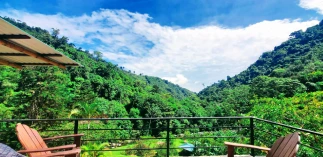High in the cool Costa Rican mountains, amidst the emerald embrace of the cloud forest, you might catch a glimpse of a vibrant flash of yellow flitting through the branches. This is the Cape May warbler, a small songbird that graces our mountain retreats only during its migratory journeys.
While not native to Costa Rica, the Cape May warbler is a fascinating visitor that graces our highlands with its presence during spring and fall migration. Let’s delve into the world of this enigmatic songbird!
A Dashing Double Life
The Cape May warbler (Setophaga tigrina) boasts a dramatic difference between its breeding plumage and its non-breeding attire. During the summer months in the far northern regions of North America, the male Cape May warbler dons a stunning outfit. His back is a rich chestnut brown, contrasting beautifully with a bright yellow breast adorned with sharp black streaks. A vibrant orange patch adorns his cheek, adding a touch of fire to his appearance.
However, by the time this little traveler reaches Costa Rica, his attire is far more subdued. Both males and females sport a greyish-olive crown and back, with a paler yellow breast that still retains some faint streaking. The orange cheek patch is replaced by a grayish one, making them much less conspicuous.
A Life Among the Spruces
The Cape May warbler is a creature of the boreal forests, preferring the towering spruce trees of the North American taiga. Here, they flit amongst the branches, adeptly searching for insects and spiders hidden amongst the needles. Their sharp bill allows them to probe bark crevices and extract hidden prey.
During their migration through Costa Rica, they tend to favor similar habitats. They are most commonly seen in the mountain ranges, particularly in areas with planted spruce trees that offer a familiar environment.
A Sweet Tooth Surprise
One of the most interesting features of the Cape May warbler is its unique tongue. Unlike most warblers, their tongue is specially adapted for a sweet tooth! It’s curled and semi-tubular, allowing them to efficiently extract nectar from flowers. This adaptation comes in handy during their migration when insects might be less abundant.
A Transient Treasure
Spotting a Cape May warbler in the Costa Rican mountains is a delightful treat for birdwatchers. Their vibrant presence, even in their non-breeding attire, adds a touch of exotic beauty to our cloud forests. While their stay might be brief, their journey through our highlands is a testament to the incredible adaptability and resilience of these remarkable little songbirds.
Have you ever spotted a Cape May warbler during your Costa Rican adventure? Share your experience in the comments below!
Coming Up Next…
Our next blog post will explore the dazzling world of the resplendent quetzal, a true icon of the Costa Rican cloud forest. Keep an eye out for it!
For more information, please view our comprehensive guide about the birds of Costa Rica







